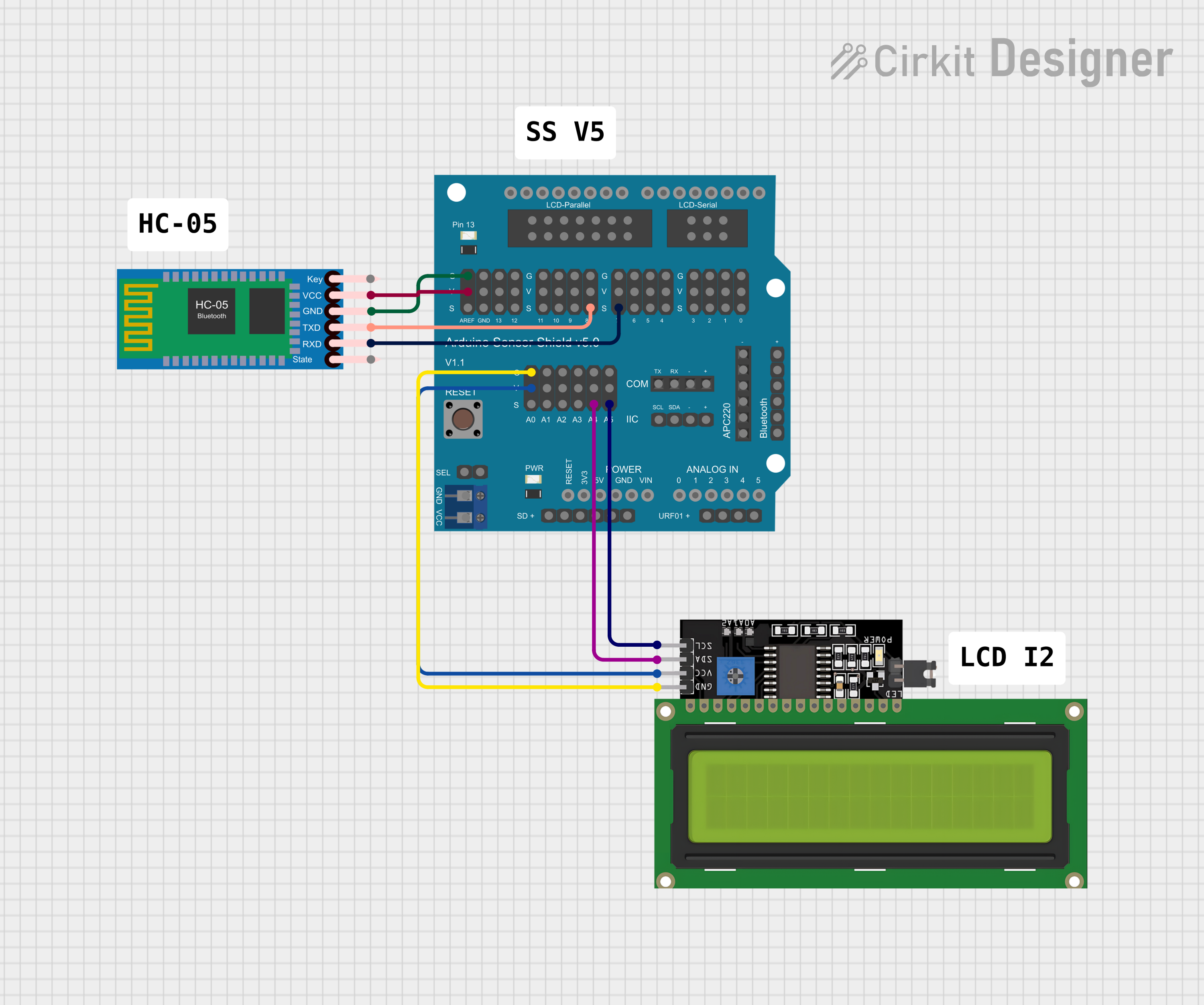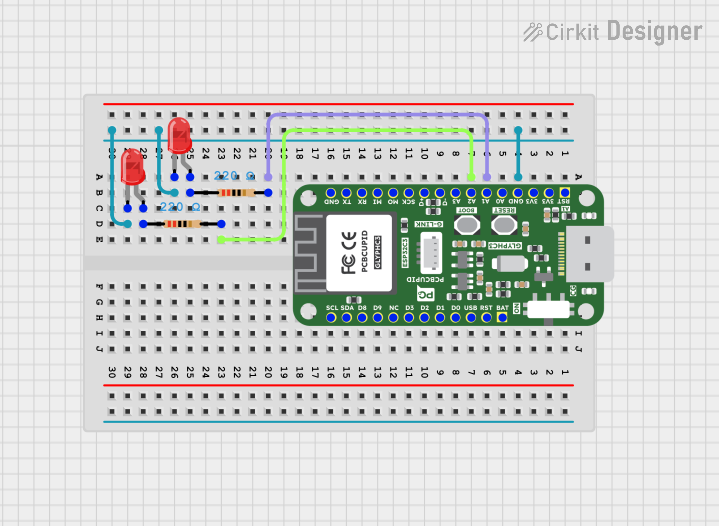
How to Use GLYPHSENSE-SHT45: Examples, Pinouts, and Specs

 Design with GLYPHSENSE-SHT45 in Cirkit Designer
Design with GLYPHSENSE-SHT45 in Cirkit DesignerIntroduction
The GLYPHSENSE-SHT45 is a high-precision digital temperature and humidity sensor manufactured by PCBCUPID (Part ID: GSI002). This sensor is designed to provide accurate environmental measurements in a compact and energy-efficient package. Its digital output simplifies integration into a wide range of applications, including:
- HVAC (Heating, Ventilation, and Air Conditioning) systems
- Weather monitoring stations
- Smart home devices
- Industrial automation
- IoT (Internet of Things) applications
With its robust design and reliable performance, the GLYPHSENSE-SHT45 is an excellent choice for applications requiring precise environmental monitoring.
Explore Projects Built with GLYPHSENSE-SHT45

 Open Project in Cirkit Designer
Open Project in Cirkit Designer
 Open Project in Cirkit Designer
Open Project in Cirkit Designer
 Open Project in Cirkit Designer
Open Project in Cirkit Designer
 Open Project in Cirkit Designer
Open Project in Cirkit DesignerExplore Projects Built with GLYPHSENSE-SHT45

 Open Project in Cirkit Designer
Open Project in Cirkit Designer
 Open Project in Cirkit Designer
Open Project in Cirkit Designer
 Open Project in Cirkit Designer
Open Project in Cirkit Designer
 Open Project in Cirkit Designer
Open Project in Cirkit DesignerTechnical Specifications
Key Specifications
| Parameter | Value |
|---|---|
| Supply Voltage (VDD) | 2.4V to 5.5V |
| Average Current Consumption | 0.4 µA (at 1 Hz measurement) |
| Temperature Range | -40°C to +125°C |
| Temperature Accuracy | ±0.1°C (typical) |
| Humidity Range | 0% RH to 100% RH |
| Humidity Accuracy | ±1.5% RH (typical) |
| Communication Interface | I²C (up to 1 MHz) |
| Operating Temperature | -40°C to +125°C |
| Package Dimensions | 2.5 mm x 2.5 mm x 0.9 mm |
Pin Configuration
The GLYPHSENSE-SHT45 has a 4-pin configuration, as detailed below:
| Pin Number | Pin Name | Description |
|---|---|---|
| 1 | VDD | Power supply input (2.4V to 5.5V) |
| 2 | GND | Ground |
| 3 | SDA | I²C data line |
| 4 | SCL | I²C clock line |
Usage Instructions
Connecting the GLYPHSENSE-SHT45
To use the GLYPHSENSE-SHT45 in a circuit, follow these steps:
- Power Supply: Connect the VDD pin to a 2.4V to 5.5V power source and the GND pin to ground.
- I²C Communication: Connect the SDA and SCL pins to the corresponding I²C data and clock lines of your microcontroller. Use pull-up resistors (typically 4.7 kΩ) on both SDA and SCL lines.
- Addressing: The GLYPHSENSE-SHT45 has a fixed I²C address of
0x44.
Example: Using with Arduino UNO
Below is an example of how to interface the GLYPHSENSE-SHT45 with an Arduino UNO:
Circuit Diagram
- Connect the VDD pin to the Arduino's 5V pin.
- Connect the GND pin to the Arduino's GND pin.
- Connect the SDA pin to the Arduino's A4 pin.
- Connect the SCL pin to the Arduino's A5 pin.
Arduino Code
#include <Wire.h>
// I2C address of the GLYPHSENSE-SHT45 sensor
#define SHT45_ADDRESS 0x44
void setup() {
Wire.begin(); // Initialize I2C communication
Serial.begin(9600); // Start serial communication for debugging
Serial.println("GLYPHSENSE-SHT45 Sensor Initialization...");
}
void loop() {
Wire.beginTransmission(SHT45_ADDRESS);
Wire.write(0xFD); // Command to trigger a measurement
Wire.endTransmission();
delay(10); // Wait for measurement to complete
Wire.requestFrom(SHT45_ADDRESS, 6); // Request 6 bytes of data
if (Wire.available() == 6) {
uint16_t temp_raw = (Wire.read() << 8) | Wire.read(); // Read temperature
Wire.read(); // Skip CRC byte
uint16_t hum_raw = (Wire.read() << 8) | Wire.read(); // Read humidity
Wire.read(); // Skip CRC byte
// Convert raw data to human-readable values
float temperature = -45 + 175 * (temp_raw / 65535.0);
float humidity = 100 * (hum_raw / 65535.0);
// Print results to the Serial Monitor
Serial.print("Temperature: ");
Serial.print(temperature);
Serial.println(" °C");
Serial.print("Humidity: ");
Serial.print(humidity);
Serial.println(" %RH");
} else {
Serial.println("Error: No data received from sensor.");
}
delay(1000); // Wait 1 second before the next reading
}
Best Practices
- Use decoupling capacitors (e.g., 0.1 µF) near the VDD pin to stabilize the power supply.
- Ensure proper pull-up resistors are used on the I²C lines for reliable communication.
- Avoid exposing the sensor to extreme conditions (e.g., condensation) to maintain accuracy and longevity.
Troubleshooting and FAQs
Common Issues and Solutions
| Issue | Possible Cause | Solution |
|---|---|---|
| No response from the sensor | Incorrect I²C address or wiring | Verify wiring and ensure the address is 0x44. |
| Inaccurate temperature or humidity | Sensor exposed to contaminants | Clean the sensor or replace if damaged. |
| I²C communication errors | Missing pull-up resistors on SDA/SCL | Add 4.7 kΩ pull-up resistors to SDA and SCL. |
| Sensor not powering on | Insufficient power supply | Ensure VDD is within the 2.4V to 5.5V range. |
FAQs
Can the GLYPHSENSE-SHT45 operate in high humidity environments?
Yes, the sensor can measure up to 100% RH, but prolonged exposure to condensation should be avoided.What is the maximum I²C clock speed supported?
The GLYPHSENSE-SHT45 supports I²C clock speeds up to 1 MHz.How do I ensure long-term accuracy?
Avoid exposing the sensor to dust, chemicals, or extreme conditions. Periodic calibration may also help maintain accuracy.Can I use the sensor with a 3.3V microcontroller?
Yes, the sensor operates within a voltage range of 2.4V to 5.5V, making it compatible with 3.3V systems.
This concludes the documentation for the GLYPHSENSE-SHT45. For further assistance, refer to the manufacturer's datasheet or contact PCBCUPID support.